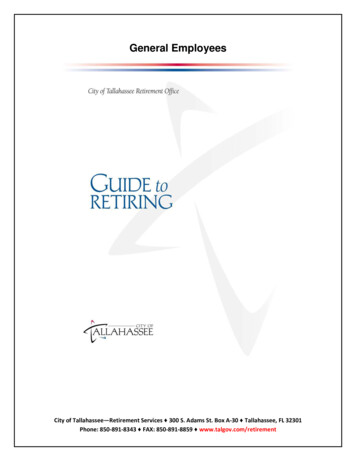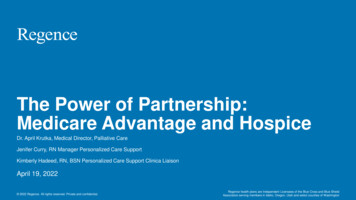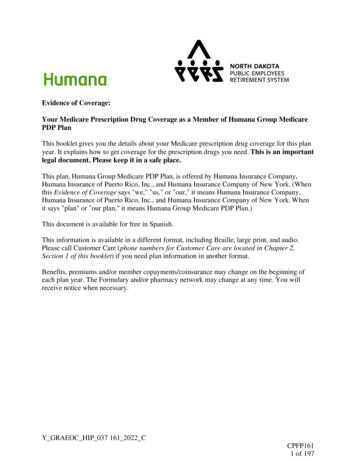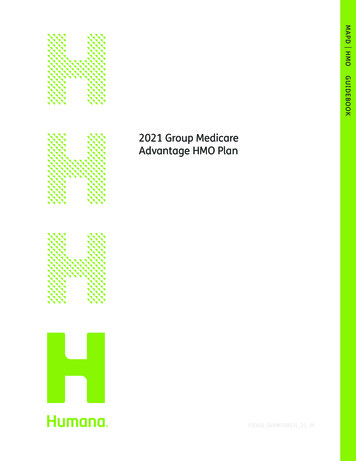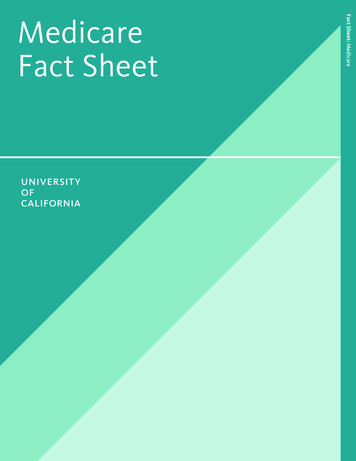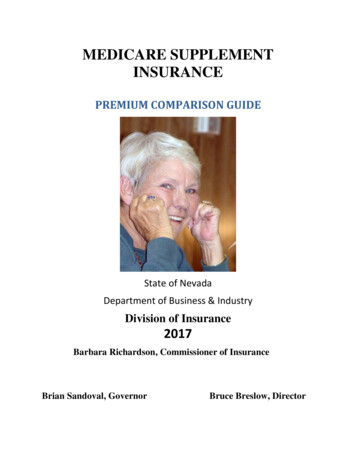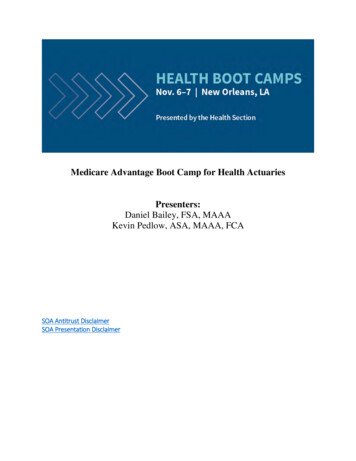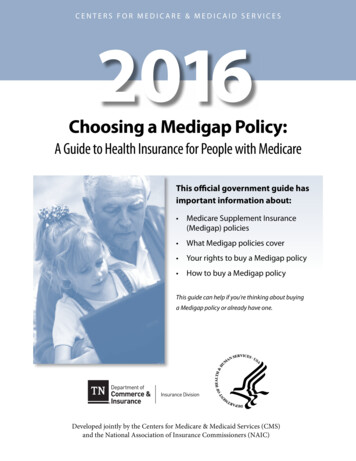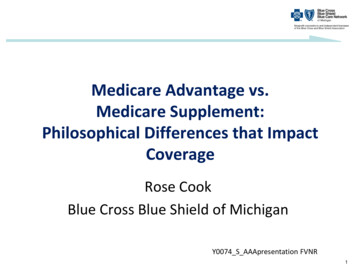
Transcription
tu-rsuant to your request of May 7, 1970 (encl. 111, we a r e submitting a report (encl. I) on our review of Medicare payments made byMichigan Medical Service (Blue Shield) for the services of salaried supervisory and teaching physicians at Wayne County General Hospital inEloise, Michigan. The physicians involved-were county employees whowere paid annual salaries by the hospital. The hospital is affiliatedwith the University of Michigan and Wayne State University medicalschools which provide training to residents, interns, and medicalstudents at the hospital. The Medicare payments discussed in thisfourth report submitted pursuant to your request were made under theSupplementary Medical Insurance Benefits f o r the Aged (part B) portion of the Medicare program,The Medicare program is administered by the Social SecurityAdministration (SSA), Department of Health, Education, and Welfare,which has entered into contracts with various private insurance companies, such as Blue Shield organizations, to make benefit paymentsfor physicians I services.Following is a summary of the information that we obtained atthe hospital relating to the points of interest specified in your letter ofMay 7. These matters a r e discussed in more detail in enclosure I onthe cited page references.- - F r o m March 1967 through June 1969, the hospital receivedabout 371,000 in part B Medicare payments or the services ofits salaried physicians. These salaried physicians involved(1) supervisory and teaching physicians who supervised the medical care provided in the hospital wards and operating rooms and(2) specialists such a s radiologists and pathologists. The payments related to services provided since July 1966. The billsfor the services of the supervisory and teaching physicians wereon a fee-for-service basis and were submitted by the hospitali n the names of specific physicians for specific medical andsurgical services provided to specific Medicare patients. (See *pp. 3 to 5.)
i1B- 164031(4)--Our comparison of claims paid by Blue Shield with the medicalrecords applicable to 50 Medicare patients indicated that theprofessional services, for which bills on a fee-for-service basis had been made by the hospital on behalf of its supervisoryphysicians, generally had been provided by residents and interns and not by supervisory physicians. Services provided byresidents and interns were not eligible for billing on a fee-forservice basis under part B of the Medicare program, but thesalaries of the residents and interns were reimbursable to thehospital under the Hospital Insurance for the Aged (part A)portion of the Medicare program. Ln addition, a portion of thesalary costs applicable to certain administrative, teaching, andsupervisory activities of the supervisory physicians w e r e a l s oreimbursable to the hospital under part A. If reimbursementwere to be made under both parts A and 3 for the same s e r vices, the Medicare program would be paying for such servicestwice.According to the hospital's medical records for the 50 patients,supervisory and teaching physicians were involved in providingabout 4 percent of the number of services for which chargesfor daily hospital visits had been billed in their names. Also,for eight of the 28 bills for surgery included in our sample, themedical records did not indicate the presence of supervisoryphysicians during the surgery which had been performed byresidents. (See pp. 6 to 11.)--On the basis of claims submitted by Wayne County GeneralHospital for reimbursement under part A of the Medicare program, we estimate that the amounts claimed under part A andthe 371,000 paid under part B for the services of all its salaried physicians exceeded the hospital's reimbursable costs byas much as 115,000 for the 3-year period ended June 3 0 , 1969.The hospital and Blue Shield advised us that the accuracy of thehospital's claims for reimbursement under part A of the program was questionable and that they were awaiting the completion of an audit by the part A intermediary (Blue Cross) t o2
B-164031(4)resolve this problem, We believe that, in making a final determination of the Medicare reimbursement to Wayne County Gene r a l Hospital under both parts A and B of the program, thepart B payment already received by the hospital should be considered and any excess paymenb should be recovered., (Seepp. 14 to 16.)--InApril 1964, the Wayne County Board of Supervisors established a fund designated as the Wayne County General HospitalMedical Staff Research and Development Fund., The a m o u n t scollected under part B of the Medicare program, together withamounts collected under private medical insurance for the professional fees of the hospital's physicians, were initially deposited with the county. The county distributed the fundsannually--the first 70,000 to the hospital r e s e a r c h and development fund and the next 180,000 to the county; any remainingbalance was to be distributed in the ratio of 40 percent to ther e s e a r c h and development fund and 60 percent to the county.(See pp. 4 and 5.)--The hospital has attempted to collect the deductible and coinsurance portions of the physicians' charges from the Medicarepatients. The 50 patients included in our review were responsible for paying deductibles and coinsurance amounting to 2,215 of the charges of 8,934 allowed by Blue Shield or dailymedical care, surgery, and consultations. A s of May 1, 1970, 1,469 or about 65 percent of the 2,215 had been collected bythe hospital, principally from the Medicaid program and fromBlue Shield under its private insurance policies that supplemented Medicare. Because the Medicare patients, at the timeof admission, authorized the hospital to bill for any benefits dueon their behalf, the patients were not required under SSA regulations to sign each bill authorizing payment to be made to thehospital for the services of specific physicians. The Medicarepatients, however, were notified by Blue Shield of paymentsmade on their behalf. (See pp. 17 and 18.)3
B- 16403l ( 4 )--The hospital's charges under part B of the Medicare programfor the professional services of its salaried supervisory andteaching physicians were based on certain fee schedules. (Seepp. 3 and 4.) We believe--and §SA and Blue Shield agree--that,on the basis of their acceptance of the results of our review ofthe hospital's medical records, the use of these fee scheduleswas not appropriate because it was questionable whether manyof the services billed had been personally furnished by thephysicians in whose names the bills had been submitted. BlueShield also advised u s that it had concluded that a more appropriate payment mechanism for physicians' professional s e r vices at the hospital would be a per diem rate. We believe that,if such a per diem rate were based on the hospital's cost ofproviding the services, the payment method favored by BlueShield would be a reasonable one. (See pp. 1 2 and 13.)--The hospital has billed private insurance companies on a feefor- service basis for the services of its supervisory and teaching physicians since before the effective date of the Medicareprogram (July 1964). Also, beginning in January 1949, the hospital billed the Medicaid program on a fee-for-service basisfor physicians' services to patients eligible for assistance uder that program. Our test of bills showed that the hospital'sfees to private insurers were comparable to the fees that Medicare had been billed for like services and that, in most cases,the private insurers had honored the claims. (See p. 19.)--After the issuance of SSA's April 1969 guidelines which setforth more clearly the circumstances under which Medicarepayments for services provided by supervisory and teachingphysicians could be made, Blue Shield, in August 1969, curtailed part 3 payments to 16 hospitals in Michigan, includingWayne County General Hospital. In December 1969, Blue Shieldmade an audit at Wayne County General Hospital and concludedthat the hospital was not complying with the revised guidelines4
B- 164031 (4)because 74 of the 100 medical records reviewed by Blue Shielddid not support the related bills. As of October 1, 1970, BlueShield had not resumed part 3 payments to the hospital. (Seepp. 11 4 12.)On May 21, 1970, the House of Representatives passed House bill17550 entitled "Social Security Amendments of 1970." One of the provisions of the bill would change the basis for reimbursement for services provided by supervisory and teaching physicians under part B ofthe Medicare program from a fee-for-service basis to a costreimbursement basis when the physicians' services are provided in asetting containing either of the following circumstances:--The mon-Medicare patients, even when able t o pay, a r e not obligated to pay the billed charges for physicians' services.--Some or all of the Medicare patients do not pay the deductibleand coinsurance amounts related to the physicians' charges o rsuch payrnents are not made on their behalf.Under the bill, the cost reimbursement would be 100 percent ofthe reasonable costs of such services to the hospital o r other medicalservice organization, including medical schools. It would therefore beunnecessary for those institutions to obtain the deductible and coinsurance amounts from the individual Medicare beneficiaries. Accordingto the report of the Committee on Ways and Means (H. Rept. 91-1096)which accompanied the bill, the cost-reimbursement approach w o d densure equitable p a p n auldtno loss to the hospitals for services provided to Medicare patients arid would a l s o simplify billing.We believe that our report will be of interest to your Committeein its consideration of the supervisory and teaching physicians' provisions of House bill 17550, because it presents an actual situation inwhich services provided by physicians at a hospital could be paid f o ron a fee-for-service basis under the House bill, but where, in our5
1B- 164031(4)opinion, a cost-reimbursement method may be more appropriate underthe various requirements contained in existing SSA regulations.IAs stated previously, private insurers have paid the hospital'scharges for the professional services provided by its supervisory physicians to individual patients; therefore, the hospital could meet thecondition in the House bill that, to bill Medicare on a fee-for-servicebasis, non-Medicare patients must be obligated to pay the billed chargesfor physicians' services. Because the deductible and coinsuranceamounts applicable to Medicare patients have been billed by WayneCounty General Hospital and in many cases have been paid by the Medicaid program or by private insurers under their medical insurancepolicies that supplement Medicare, the hospital would also be eligiblefor this reason to bill Medicare on a fee-for-service basis under theHouse bill.Under existing SSA regulations, however, we believe that the feefor-service basis used by Blue Shield in reimbursing Wayne CountyGeneral Hospital was not an appropriate method of paying for the s e r vices of the supervisory and teaching physicians at the hospital because(1) according to the hospital's medical records, the specific servicesfor which payments were made had been generally performed by onlyresidents and interns whose salaries were reimbursable to the hospitalunder part A and (2) in most cases, the medical records lacked documentation to establish that the Medicare patients had an attending supervisory physician who exercised full personal control over the careof the patient during the period of his hospitalization.In view of the foregoing factors, we believe that the application ofthe cost-reimbursement method for reimbursing hospitals for servicesprovided by supervisory and teaching physicians in a teaching settingmay be l e s s costly to the program and l e s s burdensome to administer,particularly in such situations as those at Wayne County General Hospital where the physicians a r e salaried employees of a hospital and thehospital is reimbursed for a variety of services provided by these physicians, including some services which may be reimbursable under6
B- 164031(4)part A and other services which may be reimbursable under part B ofthe Medicare program.The matters discussed in enclosure I were presented to SSA,Blue Shield, and the hospital for review. Their written comments wereconsidered by us in the preparation of our report. The hospital statedthat the absence of documentation in the medical records for servicesprovided by supervisory and teaching physicians for which bills hadbeen submitted by the hospital did not mean that these services had notactually been provided by the physicians.Pursuant to agreements with the Committee, copies of this reporta r e being sent to the Secretary of Health, Education, and Welfare andthe Commissioner of Social Security. A similar report is being sent tothe Chairman of the Committee on Ways and Means, House ofRepresentative s.Sincerely yours,Comptroller Generalof the United StatesEnclosures-2The Honorable Russell B. LongChairman, Committee on FinanceUnited States Senate7
ENCLOSURE IPage 1GENERAL ACCOUNTING OFFICEEXAMINATION INTOMEDICARE PAYMENTS FOR SERVICES OFSALARIED SUPERVISORY AND TEACHINGPHYSICIANS AT F ? A m COUNTY GENEMLHOSPITAL, ELOISE , MICHIGANMEDICARE PROGRAMThe Medicare health insurance program was establishedunder title XVIII of the Social Security Act (42 U.S.C. 1395),effective July 1, 1966. The Medicare program is administeredby the Social Security Administration (SSA) Department ofHealth, Education, and Welfare ( H E W ) , which has entered intocontracts with various insurance companies, such as BlueCross and Blue Shield organizations, to make payments underthe program.Medicare provides two forms of health protection foreligible beneficiaries aged 65 and over. One form, designated as Hospital Insurance Benefits for the Aged (part A),covers inpatient hospital services as well as posthospitalcare in an extended-care facility or in the patient's home.Payments for this protection are made from a trust fund financed through a social security payroll tax, Blue Cross isthe principal organization that makes part A benefit paymentsin Michigan.The second form, designated as Supplementary MedicalInsurance Benefits for the Aged (part B), covers physicians'services. Part B benefits are paid from a trust fund financed through premiums paid by beneficiaries electing toparticipate and matching contributions from funds appropriated by the Federal Government. Effective April 1, 1968, themonthly premium was increased from 3 to 4 ; effective July 1,1970, the premium was increased to 5.30. The beneficiary isresponsible for paying the first 50 for covered services ineach year (deductible) and 20 percent of the reasonable
ENCLOSURE IPAGE 2charges in excess of the first 50 (coinsurance). MichiganMedical Service (Blue Shield) is the organization that makespart B benefit payments in Michigan.1Payments for services provided by supervisory and teaching physicians at teaching hospitals are allowed by SSA regulations under part 3 . For the services to qualify, the physician must be the Medicare patient's "attending physician,"and either render services personally or provide "personaland identifiable direction to residents and interns" participating in the care of the patient. The salary costs of hospital residents and interns under an approved training program are reimbursable to the hospital under part A of theprogram.Where physicians are paid salaries by the hospital, SSAregulations authorize part B payments to the hospital for thephysicians' personal services to individual hospital patients.To the extent that these hospital-based physicians are compensated by the hospital for services other than direct patient care, such as teaching, research, administration, andsupervision of technical personnel, the reasonable cost ofthese services is reimbursable to the hospital under part A.SSA regulations provide, however, that the sum of the payments t o the hospital under parts A and B should be aboutequal to the amount of the physicians' compensation allocableto the Medicare program except in certain circumstances where,prior to the start of the Medicare program, the hospital'spart B charges for physicians' services had been identifiedseparately from the hospital's part A charges for hospitalservices.% h e Travelers Insurance Company, operating under a contractwith the Railroad Retirement Board ( R I B ) , makes part B benefit payments on a nationwide basis for RRl3-related beneficiaries and, accordingly, administers a small portion of thepart 3 Medicare program in the same geographical areacovered by Blue Shield.
ENCLOSURE IPage 3MEDICAL CARE AND PHYSICIANS'BILLING ARRANGEMENTSAT --WAYNZ SOUNTY GENERAL HOSPITALWayne County General Hospital, operated by the countygovernment, has three divisions--psychiatric,extended care,and general hospital. Our review involved only the generalhospital division which has about 430 inpatient beds, hasemergency and outpatient facilities, and offers the fullrange of usual medical services. The hospital is affiliatedwith the University of Michigan and Wayne State Universitymedical schools.In 1969, operating expenses of the general hospital division totaled 15 million. About 21 percent of the patientdays were covered under part A of the kdicare program. Medical care in the general hospital division was provided byabout 70 salaried staff physicians and 270 residents and interns, The residents and interns were participating in various training programs at the hospital approved by the American Pledical Association. About 80 paid medical consultantsand about 40 voluntary medical consultants were availableto assist the medical staff as needed.Basis for hospital's chargesfor physicians' servicesStaff physicians at the hospital are county employeesand are paid an annual salary. All staff physicians haveassigned to the hospital their right to bill and retain fundsreceived for services provided to patients in the hospital.Bills under part B of the Medicare program for physicians'services were made by the hospital in the names of physicians-usually the heads of departments or wards. Blue Shield madepayments or these services directly to the hospital.In August 1969, when Blue Shield curtailed payments tothe hospital for part B services, the hospital changed itsmethod of billing for such services. The hospital then beganpreparing bills or daily care and surgery in the name of individual physicians who certified that they rendered the services. If and when part B payments are resumed, Blue Shieldofficials advised us that the checks would be issued to thephysicians. Hospital officials advised us, however, that
ENCLOSURErPage 4they would then require the physicians to turn the funds overto the hospital.Fees charged for daily care and surgery from July 1966through 1967 were based on the suggested fee schedules inthe Michigan Blue Shield Physician's Manual. The physicians'part B charges for certain ancillary services, such as forradiology and laboratory work, were based on percentages ofthe fees shown in these schedules. Starting in 1968, thehospital based its fees on a relative-value study prepared bythe Michigan State Medical Society. The hospital consideredthis study to be a more up-to-date basis for establishingfees. Under a relative-value study, unit values are assignedto each type of medical and surgical service. The hospitaldetermined the fees by multiplying the unit values assignedto the type of service by a rate of 5.Hospital's dispositionof fees receivedIn April 1 9 6 4 , the Wayne County Board of Supervisorsestablished a fund for hospital staff education and research.A portion of the fund's revenue was to come fro3 fees receivedfor professional services of salaried staff physicians atWayne County General Hospital.The fund established by the board of supervisors wasdesignated as the Wayne County General Hospital Medical StaffResearch and Educational F'und and was to be used to supportthe following objectives:--Continuing and improving the present level of patientcare.--Attracting and retaining well-qualified physicians,residents, and interns.--Assisting the permanent staff to keep abreast of therapidly changing techniques and procedures in the medical profession.--Providing funds for "pilot" research so that researchgrants may be obtained from national ar,d private agencies.
ENCLOSURE IPage 5--Contributing to the advancement of medical knowledgethrough research.Fees received by the hospital for physicians' servicesunder part B and from other sources, such as private medicalinsurance companies, were deposited in the general fund ofIJayne County. The county distributed the funds annually--thefirst 70,000 to the research and development fund and thenext 180,000 to the county; any remaining balance was to bedistributed in the ratio of 40 percent to the research anddevelopment fund and 60 percent to the county.Part B Medicare payments of 371,0001 were received bythe hospital between March 1967 and June 1969 and related toservices rendered since July 1966. The hospital also received 120,000 during the same period from the Michigan State Medicaid program for physicians' services. Most of these Medicaidpayments represented the Medicare part B deductible and coinsurance amounts or patients eligible for benefits under bothprograms.The hospital reported that, during the 3-year periodended November 1969, total receipts from fees for physicians'services amounted to about 1.7 million. Therefore, paymentsreceived under the Medicare and Medicaid programs representedabout 30 percent of the total funds received by the hospitalfor the services of its salaried staff physicians.the 371,000 Medicare part B payments received by thehospital, about 5,000 was received from The TravelersInsurance Company for services rendered to RRB-related beneficiaries; the balance of 366,000 was received from BlueShield.'Of
ENCLOSURE IPage 6REVIEW OF MEDICAL RECORDS FOR SERVICESOF SUPERVISORY AND TEACHING PHYSICIANSCHARGED TO THE MEDICARE PROGRAMOur comparison of the part B bills with the medical records applicable to 50 Medicare patients indicated that theprofessional services, for which bills on a fee-for-servicebasis had been made by the hospital in the names of supervisory physicians, generally had been provided by residents andinterns and not by supervisory physicians. Services providedby residents and interns were not eligible for billing on afee-for-servicebasis under part B of the Medicare program,but their salaries were reimbursable to the hospital underpart A of the program. If reimbursement were made under bothparts A and B , the Medicare program would be paying twice forthe same services.In most cases the records lacked documentation, as required by SSA regulations and guidelines, to establishwhether the patient had an attending supervisory physicianwho exercised full personal control over the care of the patient during his hospitalization.SSA regulations issued in August 1967' describe the basis for payments f o r services of supervisory or teaching physicians as follows:"(b) Payment on the basis of reasonable charges isapplicable to the professional services rendered toa beneficiary by his attending physician where theattending physician provides personal and identifiable direction to interns o r residents who are participating in the care of his patient. *** The carrying out by the physician of these responsibilitieswould be demonstrated by such action as: Reviewingthe patient's history and physical examination andpersonally examining the patient within a reasonableperiod after admission; confirming or revising'The SSA regulations were published in February 1967 in theFederal Register as a proposed rule.
ENCLOSUREIPage 7diagnosis; determining the course of treatment to befollowed; assuring that any supervision needed bythe interns and residents was furnished; and by making frequent reviews of the patient's progress."In April 1969, SSA issued revised guidelines to setforth more clearly the circumstances under which paymentson a fee-for-service basis may be made for the services ofsupervisory or teaching physicians and the documentation required to support such payments, Some of the more importantprovisions are as follows:1"The physician must be the patient's 'attendingphysician.' This means he must *** render sufficient personal and identifiable medical services tothe Medicare beneficiary to exercise full, personalcontrol over the management of the portion of thecare for which a charge can be recognized; his services to the patient must be of the same character,in terms of the responsibilities to the patient thatare assumed and fulfilled, as the services he renders to his other paying patients.***Jr*'l3. Performance of the activities *** must be demonstrated, in part, by notes and orders in the patient's records that are either written by or countersigned by the supervising physician.""IThe term 'physician' does not include any residentor intern of the hospital regardless of any othertitle by which he is designated or his positionon the medical staff."From March I967 to June 1969, the hospital receivedabout 371,000 in part B payments for the services renderedsince July 1966 to Medicare patients by its salaried staffphysicians, including such specialists as radiologists andpathologists. We selected 50 patients at random for whompart 3 payments of 8,140 had been made by Blue Shield. Of
ENCLOSURE IPage 8these payments, 6,719 was or daily care, surgery, and consultations and 1,421 was for radiology, electrocardiograms,and pathology (laboratory) services.The part B charges for the latter three types of services ranged from 5 to 25 percent of the total hospitalcharge. The total hospital charge included (1) the hospital'scosts for the salaries of technical personnel and the cost ofsupplies and equipment which are reimbursable under part Aand (2) the "professional component" or fees for physicians'personal services to patients which are reimbursable underpart B. We did not review the charges for radiology, electrocardiograms, or pathology services because the SSA regulationsdealing with supervisory or teaching physicians were not applicable to physicians who provide these types of specializedservices.For the hospital's charges for daily medical care, surgery, and consultations that involved payments of 4 , 7 1 9 , orabout 83 percent of the payments made on behalf of the 50 patients, we compared the bills with the patients! medical records and hospital reports to determine the extent that theserecords showed the involvement of the physician in whose namethe bill.was submitted. The bills we reviewed had been submitted to Blue Shield by the hospital from April 1967 throughOctober 1969.The types and numbers of services and the amounts billedby the hospital and allowed by Blue Shield for the 50 patientsare summarized below:IhmoUtOccasions Amount allowed byof service billed Blue ShieldDaily medical careSurgeryConsultationsTotal485287- 2,8816,383120 2,764520- 9 3848,934Less deductibles and coinsurance payableby patientsTotal payments reviewed6,050--1 2 02,215 6,719
ENCLOSURE IPage 9Because of the technical nature of the data, hospitaladministrative and medical personnel and a 3lue Shield consulting physician provided us with professional assistance inour examination of the medical records. Our findings arediscussed as follows:Daily medical careFor the part B payments we reviewed, Medicare was billedin the name of a supervisory or teaching physician or dailyeach & the patient was hospitalvisits for medical care for ized, except for the surgical cases in which the preoperativeand postoperative days of medical care were included in thecharges for surgery. The daily visits were billed as follows: 15 for the first day which included a medical diagnosis,physical examination, and preparation of the patient's medicalhistory; 5 for days 2 through 21; and 4 for each additionalday.The bills pertaining to the 50 patients showed that thehospital billed Blue Shield 2,881 for 485 daily visits.Hospital and medical records containing doctors' o r d e r s , progress notes, and nursing notes did not contain documentationconfirming that 108 of the 485 daily visits had been made.Records showed that most of the remaining 377 daily visits,which were supported by physicians' notations, had been madeonly by residents and interns. The records showed a l s o thatthe supervisory or teaching physicians in whose names thebills had been submitted had been involved in only 15 of the377 daily visits. There were five visits in which othersupervisory and teaching physicians had been involved in providing daily care, For the remaining 357 daily visits, notations in the records showed that care had been rendered byresidents, interns, or students; but countersignatures orother evidence of direction by supervisory physicians wereabsenteThe hospital medical director agreed that there was alack of documentation but stated that the absence of a physician's notation did not necessarily mean that a supervisoryphysician did not visit patients or review cases. She emphasized that physicians did not have time to record all theyhad done for a patient during each day.
ENCLOSURE IPage 10SurgeryMedicare was billed 6,383 f o r physicians' services inconnection with 28 operations performed on 17 of the 50 patients. The hospital recordsj such as the operating room reports, showed that eight o the operations involving chargesof about 2,150 had been performed by residents and there wasno indication as to whether a supervisory physician was present during surgery, The charges for these eight operations-including three cataract extractions, one leg amputation, andone repair of a bro
B- 164031 (4) because 74 of the 100 medical records reviewed by Blue Shield did not support the related bills. As of October 1, 1970, Blue Shield had not resumed part 3 payments to the hospital.(See pp. 11 4 12.) On May 21, 1970, the House of Representatives passed House bill 17550 entitled "Social Security Amendments of 1970." One of the pro-
